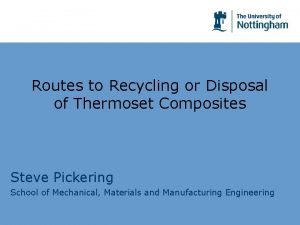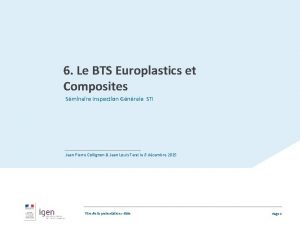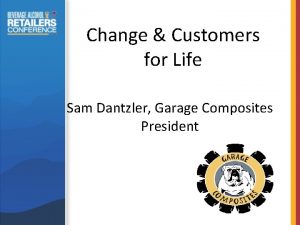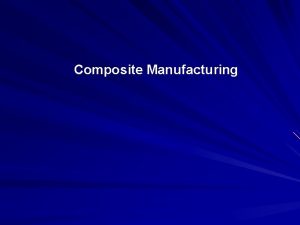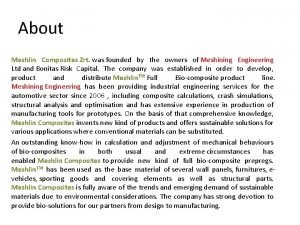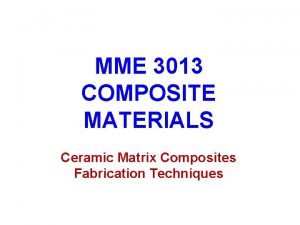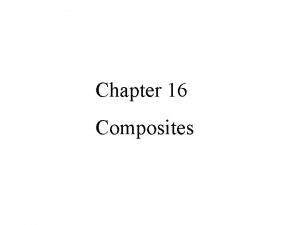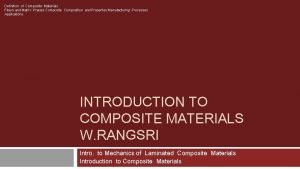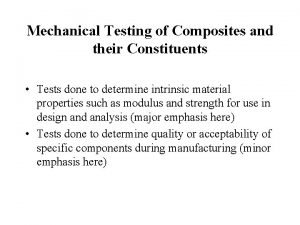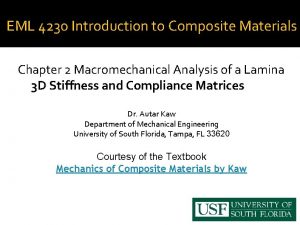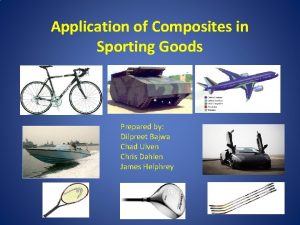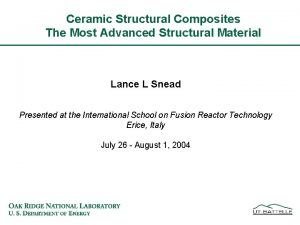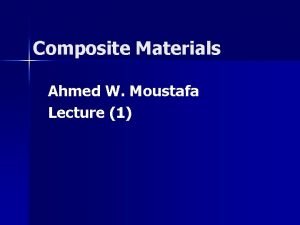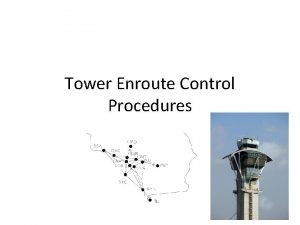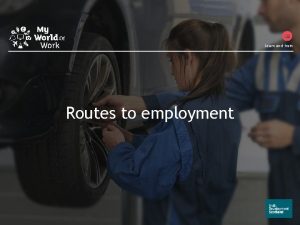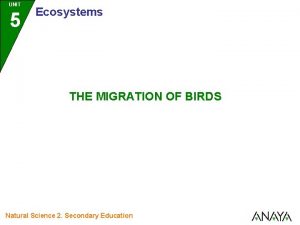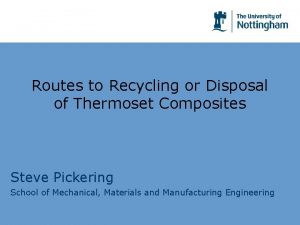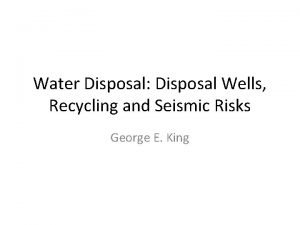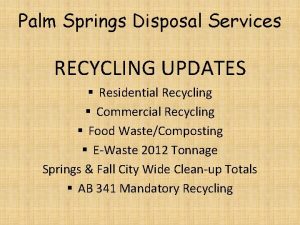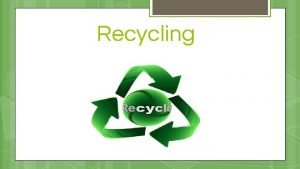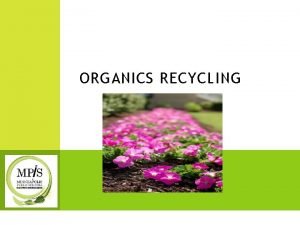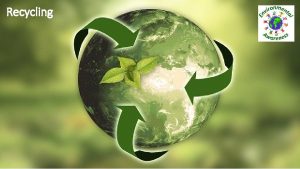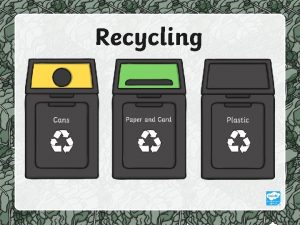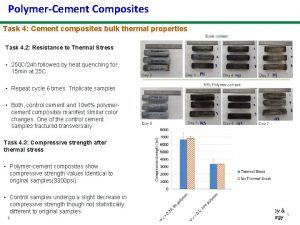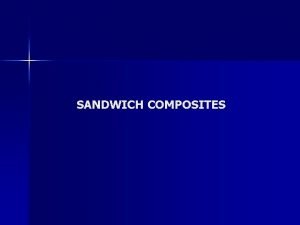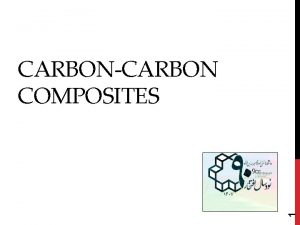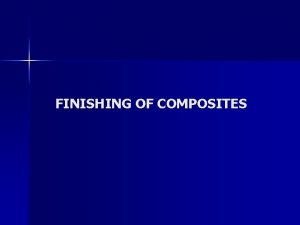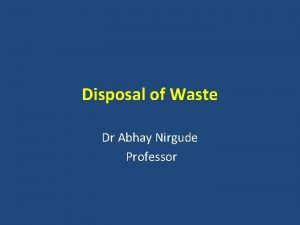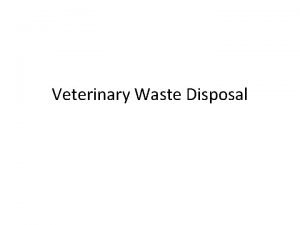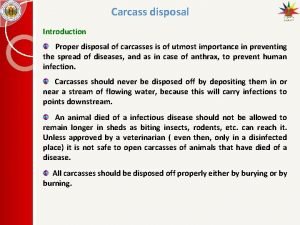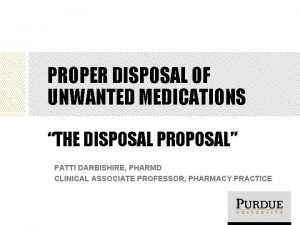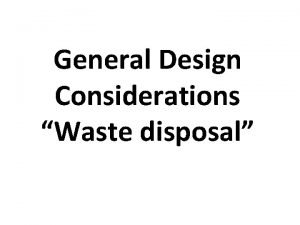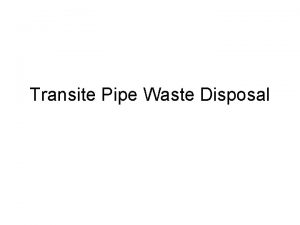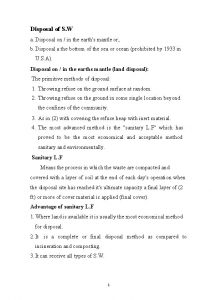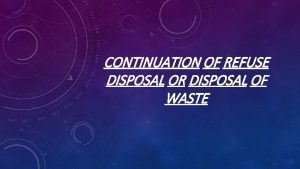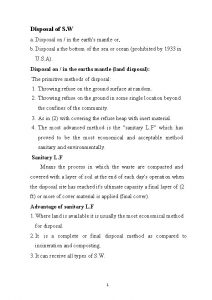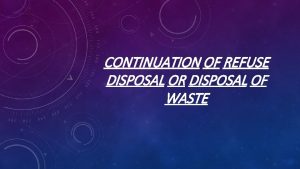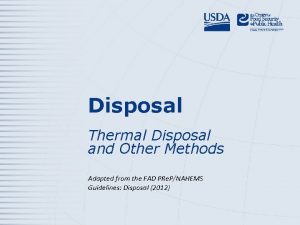Routes to Recycling or Disposal of Thermoset Composites

































- Slides: 33

Routes to Recycling or Disposal of Thermoset Composites Steve Pickering School of Mechanical, Materials and Manufacturing Engineering

Presentation Outline • Need to Recycle • Problems in recycling thermoset composites • Recycling/Disposal Processes – mechanical recycling – thermal processing • Future Prospects

Need to Recycle Pressure from legislation • EU Directives • Landfill • End-of-Life Vehicles • Waste Electrical and Electronic Equipment • Construction and Demolition Waste

Recycling Heirarchy • Prevent waste • Reuse product • Recycle material Does not measure recycling quality (environmental benefit) • Incineration • with material and energy recovery • without recovery • Landfill

Problems in Recycling Thermoset Composites • Technical Problems • Thermosetting polymers can’t be remoulded • Long fibres • Mixtures of materials (different compositions) • Contamination • Costs • Collection and Separation

Recycling Processes for Thermoset Composites Mechanical Recycling (comminution) Powdered fillers Fibrous products (potential reinforcement) Thermal Processes Combustion with energy recovery (and material utilisation) Fluidised bed process Clean fibres and fillers with energy recovery Pyrolysis/ Gasification Chemical products, fibres and fillers

Mechanical Recycling Size reduction • Coarse primary crushing • Hammer milling followed by grading to give: • Powder • Coarser fractions (reinforcement rich) All scrap material is contained in recyclate (incl. different polymers, contamination, paint…. )

Mechanical Recycling into new composites • Powdered recyclate useful as a filler (up to 25% incorporated in new composite) • Coarser recyclate has reinforcement properties (up to 50% substitution of glass fibre) Several companies have been founded to commercialise recycling – ERCOM (Germany), Phoenix Fiberglass (Canada)

Mechanical Recycling into other products • Compounding with thermoplastics • Production of reinforcement with recyclate core to allow resin flow during impregnation • Using recyclate to provide damping (noise insulation) • Alternative to wood fibre • Asphalt

Thermal Processing Combustion with Energy and Material Recovery • Calorific value of thermosetting resins ~ 30 MJ/kg • Co-combustion with municipal waste in mass burn incinerators • Co-combustion in cement kilns • Co-combustion with coal in fluidised bed

Thermal Processing Combustion with energy recovery • Calorific value depends on inorganic content (10 - 30 MJ/kg) • Filler effects: • Ca. CO 3 1. 8 MJ/kg (+800 C) • ATH 1. 0 MJ/kg • ‘Cleaner than coal’ • Bulky ash remaining

Thermal Processing Combustion with energy and material recovery Cement manufacture • energy recovery from polymer • glass and fillers combine usefully with cement minerals • fuel substitution limited to <10% by boron in E-glass Potential savings <£ 20/tonne of GRP used

Thermal Processing Combustion with energy and material recovery Fluidised Bed Coal Combustion • (Limestone filled composites) • energy recovery from polymer • limestone filler absorbs oxides of sulphur from coal • commercial trial undertaken

Thermal Processing – Fluidised Bed Process Clean flue gas To energy recovery Cyclone Afterburner Scrap CFRP 300 mm Fan Recovered Fibre Electric Pre-heaters Air Inlet Fluidised Bed Air distributor plate

Fluidised Bed Processing Scrap FRP Clean Flue Gas Fibres and fillers carried in gas flow Fluidised Bed Materials and Energy Recovery Separation of fibres and fillers Secondary Combustion Chamber Recovered Fibres Fillers Heat Recovery Recovered Energy

Fluidised Bed Operation • Temperature: 450 to 550 deg C • Fluidising air velocity: up to 1. 3 m/s • Fluidising medium: silica sand 1 mm • Able to process contaminated and mixed composites eg: double skinned, foam cored, painted automotive components with metal inserts

Recovered Glass Fibres Properties • Strength: reduced by 50% (at 450 C) • Stiffness: unchanged • Purity: 80% • Fibre length: 3 to 5 mm (wt)

Reuse of Recycled Glass Fibre Moulding Compounds • Moulding - virgin glass fibre Moulding Compounds • Only effect is 25% reduction in impact strength • no change to processing conditions • demonstrator components produced • Moulding - 50% recycled glass fibre

Outline Process Economics Glass Fibre Recycling Commercial Plant Schematic (5000 tonnes/year)

Outline Process Economics Glass Fibre Recycling 5, 000 tons/year Annual costs: Annual Income: Capital £ 3. 75 million £ 1. 6 million £ 1. 3 million Breakeven throughput: 10, 000 tons/year

Clean flue gas Fluidised Bed Process To energy recovery Cyclone Afterburner Scrap CFRP 300 mm Fan Recovered Fibre Electric Pre-heaters Air Inlet Fluidised Bed Air distributor plate

Carbon Fibre Properties • Tensile strength reduced by 25% • Little change in modulus • No oxidation of carbon fibres

Carbon Fibre Properties Fibre Quality • Fibre surface quality similar to virgin fibre • Clean fibres produced 100 mm ~200 mm 100 m

Recovered Fibre Composite • Fibres made into polycarbonate composite Strength Stiffness

Thermal Processing Combustible Gases to heat reactor Pyrolysis Process Scrap feed Reactor Solid Products (fibres, fillers, char) Hot gases Condenser Solid and Liquid Hydrocarbon Products

Thermal Processing Pyrolysis Processes • Heating composite (400 – 800°C) in absence of air to give • hydrocarbon products – gases and liquids • fibres • Some char contamination on fibres • Hydrocarbon products potential for use as fuels or chemical feedstock • Low temperature (200°C) catalytic pyrolysis for carbon fibre Gasification – limited oxygen – no char, fuel gases evolved

Thermal Processing Products from Pyrolysis (450°C) Polyester Composite (30% glass fibre, 7% filler, 63% UP resin) 6% Gases: CO 2 & CO (75%) + H 2, CH 4 ……. 40% Oils hydrocarbons, styrene 15% Waxes phthalic anhydride (26%)……. (96%)…. . 39% Solids glass fibre & fillers (Ca. CO 3), char (16%)

What is best Recycling Route? ? • Established hierarchy and ELV Directive favour mechanical recycling techniques – but are these the best environmentally? ? • Detailed Life Cycle Analysis needed to identify environmental impact • Recent project in Sweden (VAMP 18) has considered best environmental and cost options for recycling a range of composites

Prospects for Commercial Success? • ERCOM and Phoenix – viable levels of operation not achieved • Recyclates too expensive to compete in available markets • Need to develop higher grade recyclates for more valuable markets • Legislation and avoidance of landfill are new driving forces

Value in Scrap Composites • Energy value of polymer £ 30/tonne • Value of polymer pyrolysis products Maleic Anhydride, Bisphenol A • Value of filler • Value of glass fibre • Value of carbon fibre £ 1, 000/tonne £ 30/tonne £ 1, 000/tonne £ 10, 000/tonne

New Initiative • Eu. CIA (GPRMC) initiative • ECRC (European Composites Recycling Concept) • Scheme to fund recycling to meet EU Directives • A guarantee that composites will be recycled

Conclusions • A range of technologies is under development • material recycling • thermal processing • Key barriers to commercial success are markets at right cost • Need for environmental analysis to identify best options • Future legislation is driving industry initiatives

Fluidised Bed Process Recycled Carbon Fibre • Energy use for recovery process is 10% of virgin fibre production • 40% to 45% energy reduction observed for recovered fibre composites Life Cycle Analysis
 Thermoset recycling
Thermoset recycling Warp clock composites
Warp clock composites Bts europlastics et composites
Bts europlastics et composites Brandy dantzler
Brandy dantzler Composite manufacturing processes
Composite manufacturing processes Dental composite definition
Dental composite definition Testimonal evidence
Testimonal evidence Mom zrt
Mom zrt Ceramic matrix composites definition
Ceramic matrix composites definition Classification of composites
Classification of composites Interior wall finishes material
Interior wall finishes material Matrix phase meaning
Matrix phase meaning Mechanical testing of composites
Mechanical testing of composites Isotropic material stiffness matrix
Isotropic material stiffness matrix Composites in sports
Composites in sports Structural composites industries llc
Structural composites industries llc Ceramic matrix composites definition
Ceramic matrix composites definition Maine marine composites
Maine marine composites Components and composites ofsted
Components and composites ofsted Lux express vilnius riga
Lux express vilnius riga 1500 trade routes
1500 trade routes Triangular trade routes apush
Triangular trade routes apush Cima gateway route
Cima gateway route Surveillance detection routes
Surveillance detection routes Cognitively based attitude
Cognitively based attitude Local route of drug administration
Local route of drug administration Hazmat restricted routes
Hazmat restricted routes Tower enroute control
Tower enroute control Routes to work
Routes to work Persian empire trade routes
Persian empire trade routes Ducks migrating
Ducks migrating Hitch and go route
Hitch and go route Jacques cartier legacy
Jacques cartier legacy Trade routes in the 1500s
Trade routes in the 1500s
